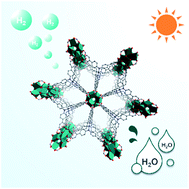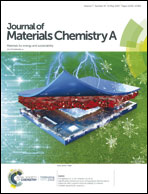Tunable titanium metal–organic frameworks with infinite 1D Ti–O rods for efficient visible-light-driven photocatalytic H2 evolution†
Abstract
Infinite 1D Ti–O rod-based metal–organic frameworks (MOFs) are promising photocatalysts for water splitting due to their high optical response and favourable photo-redox properties and stability, but have not been explored yet. In this study, three isoreticular porous 1D rod-based Ti-MOFs ZSTU-1, ZSTU-2 and ZSTU-3 are successfully constructed from infinite [Ti6(μ3-O)6(μ2-OH)6]n secondary building units (SBUs) and tritopic carboxylate linkers 4,4′,4′′-nitrilotribenzoic acid (H3TCA), 1,3,5-tris(4-carboxyphenyl)benzene (H3BTB) and tris(4′-carboxybiphenyl)amine (H3BTCA), respectively. Their porosities systematically increase with the larger and longer organic linkers. The two MOFs ZSTU-1 and ZSTU-3 built from the triphenylamino-based ligands can absorb visible light, exhibiting much better photocatalytic performance than ZSTU-2 as shown by the H2 production rate of ZSTU-1 and ZSTU-3 being 3–4 times higher than that of ZSTU-2. The photocatalytic H2 production rates for ZSTU-1, ZSTU-2, and ZSTU-3 are 1060 μmol g−1 h−1, 350 μmol g−1 h−1 and 1350 μmol g−1 h−1, respectively. The extraordinary photocatalytic activity of ZSTU-3 is attributed to its visible light absorption, large surface area, and favorable charge separation.

- This article is part of the themed collection: 2019 Journal of Materials Chemistry A Most Popular Articles

 Please wait while we load your content...
Please wait while we load your content...